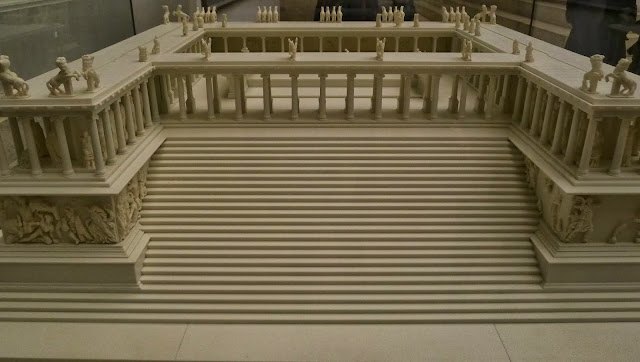[The Pergamon Altar]
I've been to a lot of museums in my life from the Smithsonian in DC to the Louvre and Orsay in Paris. I must say though that I have never ever seen anything like the exhibits at the Pergamon Museum. Entering the main floor, one is immediately floored by the massive Greek altar, complete with pillars and grand steps which is a reconstruction of the original ruins of the Pergamon Altar. Said to have been built 2,183 years ago (170 BC if my math is accurate), German engineer Carl Humann and crew excavated the entire ruins of Pergamon and shipped it to Germany to be displayed at The Pergamon.
All three sides of the massive room is covered with sculptures depicting the Battle of the Gods and the Giants and supposedly represents the "struggle of good, justice, order and civilisation versus evil, caprice and chaos.
[Market Gate of Miletus] (Roman)
In the room next door is another astounding piece of archaeology excavated by the Germans in the early 1900's. It was built in the 2nd century and brought to Pergamon shortly after it opened. This was pretty astonishing and although one can tell where the original structure has been supplemented and restored (sensibly, safety would have been a consideration), the roman pillars and the intricate mosaic tile floors transports you to a far different place and time.
[Ishtar Gate of Babylon]
...And it keeps going. I have made my mind up at this point that Pergamon is one of the best museums in the world.
The next room is a grand, majestic wall splashed in vivid royal blue tile with mosaics of animals, flowers, and other decorative figures. The contrast of bring colors is almost startling from the first two rooms. This is the Ishtar Gate of Babylon that took eighteen contiguous years to excavate (1899-1917).
[Mshatta Palace Facade]
This was a stunner, particularly because of the intricate carvings on this wall. The palace was located in Jordan and it was built in the 8th century. This was gifted to Emperor Wilhelm II and eventually made it to Pergamon.
[Brandenburger Tor]
Meanwhile, outside the Pergamon, there is another gate that is of great historical significance to Berlin - the Brandenburger Tor, a symbol of peace erected from 1788-1791. It was destroyed in World War II, but was restored in 2000-2002. When the Berlin Wall still existed, Brandenburger Tor was where President John F. Kennedy gave the historic speech only two years after the wall came up, where in a show of solidarity to the free West Berlin, he professed to the thick throng of Western Berliners, "Ich bin ein Berliner!" ("I am a Berliner"). It is the same site where Ronald Raegan later in 1987 bellowed to Gorbachev, "Tear down this wall! Where President Ronald Reagan closed the same speech with, ".. this wall will fall. For it cannot withstand faith; it cannot withstand truth. The wall cannot withstand freedom." Two years later, the wall fell.
I'm not particularly a history or an archaeology buff, but when traveling, I love immersing myself in experiences that create expansion. Berlin was a wonderful place for learning things I never thought I'd learn, I never thought I'd see in my lifetime. I'm in the conviction that if traveling doesn't add to how you know and integrate with the world, then why the bother?
























No comments:
Post a Comment